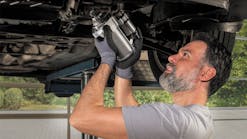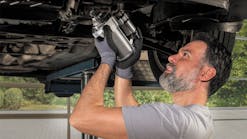In 2008, I started working for MINI Cooper at one of the local dealerships in southern California. That was my first encounter with the continuously variable transmission (CVT). Not knowing exactly how it worked, I was eager to learn. When I was sent to the training center to learn about the R50, R52 and R53 models of the MINI Cooper (this is considered the first-generation MINI), I found that only the R50 and R52 models came with the CVT transmission. These are the regular MINI Cooper Hatchback and Convertible. Seeing the cutaway display model only caused me to ask more questions about the transmission. The instructor told us that there was no fixing the faulty transmissions, and that if there was a problem, you would replace the whole assembly as opposed to fixing it. OK, I thought, no big deal.
The next time that I got a MINI that had a transmission problem that needed to be replaced; I put in the up sale and waited for the approval. The job did not get approved. When I asked the service writer what happened, he just laughed at me and said that those never get approved. I asked why, and he replied that the final quote with the transmission, tax and labor was over $9,000. I was shocked! For the next four years I did not do much with the CVT transmission — just the regular fluid flush for maintenance.
After I left the dealership in 2011, and started my own independent MINI repair shop (Figure 1), I remembered how expensive it was to get a CVT fixed. In an effort to give my customers a better deal, I found a transmission rebuilder who said that he could rebuild them. As a result, I started to advertise the CVT rebuilds on craigslist.
I soon got a call from someone who needed CVT work, and I eagerly accepted the job. The customer had the car towed in and I pulled the transmission out and sent it to the rebuilder.
After two weeks we were nowhere. We could not find parts, and after extremely thorough searches for an article, video, Partsfish or anything that would give us a direction, we found nothing. And to top it all off, the owner of the transmission shop basically said “Here is your transmission. There is nothing I can do for you, you are on your own.”
I was devastated. I’m not the type of person to give up. But I did not know what to do. And I did not want to call my customer and tell him that I could not do the job when I’m advertising that I can.
About one day later, another new customer called and asked about the CVT rebuild that I advertised. I explained what happened with the one that I had, and that I was still looking for options. He explained to me that he had bought the car to flip; he didn’t need the car so I could have it as long as I needed if it would help with the process. So I said sure — and I’m glad that I did.
I took it apart this second transmission with a video camera over my shoulder so as to capture everything. But even with the video camera, I still missed a lot of details. I ended up pulling that transmission out and apart seven more times before I got it right (Figures 2, 3 and 4). And with what I found on the second transmission, I was able to fix both transmissions — since fortunately, they had different problems.
That gave me the confidence to tackle more and more problems with the CVTs. At this point, I’ve seen about six common problems with the CVT:
1. The car does not move at all. The engine just revs in drive or reverse.
2. The car does not go faster than 30 mph. It seems to only have first gear.
3. Various leaks are coming from the transmission — but where they are coming from can determine the problem. And you will lose all your fluid and the car will not move.
4. Erratic shifting: Driving on the freeway at 70 mph, for example, and the car will rev and downshift and upshift on its own.
5. When you put the car into drive and accelerate, it does not move. If you put the pedal to the floor, the car will crawl at 1 mph and will slowly get up to speed.
6. When starting and revving the engine in park, a bearing noise gets louder, and a different bearing noise comes when the car is moving at 5 mph or faster.
These are all the problems that I’ve seen multiple times. I would say these problems are all the type that parts need to be replaced to fix the transmission and get it working correctly. However, there is one common problem that happens in the MINI that no parts are needed to fix.
Reset adaptations
The correction is to clear the CVT long-term gear adaptation values, and perform a complete transmission “adaptation teach-in” procedure. Now, you will need dealer software, an Autologic or a buddy at a German shop to do this. This is a simple quick fix, and the customer is usually ecstatic that he doesn’t need a transmission. I have fixed many CVTs this way.
The procedure with dealer software is as follows:
1. Connect the vehicle to the ISID/GT1, loaded with the latest diagnostic software.
2. Select “Service Functions”; then “Drive” and “CVT gear.”
3. From the second column, select “Replacement/adaptation, CVT transmission” and then “Test Plan.”
4. Scroll through the next screens and answer yes to the question, “Is it necessary to delete Adaptation values?” Answer yes, then an “XP” will be displayed on the instrument cluster (Figure 5, above).
After the CVT gear ratio adaptations are deleted, perform a complete transmission “teach-in” procedure, as follows:
Clutch adaptation:
1. Press and hold the brake pedal and apply the emergency brake. Start the cold engine.
2. During a cold start warm-up phase (idle speed is slightly increased), shift from P to N for 10 seconds, and then shift to D for 10 seconds (Figures 6 and 7).
3. Repeat the following sequence 10 times: Shift from P to N for 3 seconds, and then shift to D for 3 seconds. XP will be displayed in the instrument cluster.
4. Repeat the following sequence 10 times: Shift from P to N for 3 seconds, and then shift to R for 3 seconds. XP will be displayed in the instrument cluster.
After that, we go to the Gear ratio adaptation: “Perform this procedure on an open road preferably little traffic”:
1. Accelerate the vehicle to a speed of 50 mph. Release the accelerator pedal and allow the vehicle to coast down to a stop. You may have to perform this a few times. If as you’re slowing down the rpm flares up over and over, it is just being stubborn. If the MINI is being stubborn and not coming out of “X” mode, I recommend letting it sit overnight. Then when it is still cold, start it up and perform the ratio adaptations again —more than likely it will come out. The transmission adapts itself when going through 4,500 rpm, 4,000 rpm and down through 1,400 rpm engine speeds. P will be displayed now in the instrument cluster once the adaptation procedure is complete.
2. With the engine at the operating temperature (idle speed stabilized at 800 rpm), repeat Clutch Adaptation steps 3 and 4 previously mentioned.
3. Turn the ignition off. “Let the car go to sleep about 16 minutes, while the computer calculates and makes adjustments for the shifting points for the next drive cycle.”
I always advise the customer to drive in “Sport Mode” at least once a month. This is when the owner can manually shift the gears, and is done by sliding the gear shifter over to the right when it is in the “drive” position. This helps prevent the transmission from losing the adaptation. It was explained to me this way, and I adopted the explanation myself since it is easy to understand. I tell the customer that by driving the car in “sport mode” once a month or so, it’s like hitting refresh on the computer screen — as it puts the transmission in a different driving program. It keeps things fresh by going in and out of different programs, and it will not “freeze.” I believe that the flaring on deceleration is because the transmission is in the same mode all the time. It gets stuck in one mode and then loses the adaptation.
Because the transmission fluid should be changed every 30,000 miles, I incorporate an adaptation as part of the fluid change at my shop so as to prevent any comebacks. Honestly, from everything that I’ve seen, the transmission fluid flush is the best preventative maintenance you can do for it. Most people don’t know what the maintenance schedule is, so I try to educate them. On every other oil change, the transmission fluid needs to be changed as well — since MINIs can go 15,000 miles between oil changes if they are using the full synthetic MINI blend of Castrol 5W-30 oil.
I decided to make a video to teach people how to correctly teardown and rebuild the MINI Cooper CVT transmission, as well as how to identify these six common problems and what the solutions are for the fix. You can find the video and more information by visiting the website: http://minicoopercvttransmissionrebuild.com
So in a nutshell, that’s how I learned about the CVT transmission. I would recommend using the same method that worked for me. I would buy the 48-minute video, which shares information that took me two-and-a-half years of trial and error; learn the ins and outs; advertise on Craigslist and start making money.
Subscribe to Motor Age and receive articles like this every month…absolutely free. Click here
.JPG?auto=format,compress&fit=max&q=45&w=250&width=250)
.JPG?auto=format,compress&fit=max&q=45&w=250&width=250)
.JPG?auto=format,compress&fit=max&q=45&w=250&width=250)
.JPG?auto=format,compress&fit=max&q=45&w=250&width=250)
.JPG?auto=format,compress&fit=max&q=45&w=250&width=250)
.JPG?auto=format,compress&fit=max&q=45&w=250&width=250)
.JPG?auto=format,compress&fit=max&q=45&w=250&width=250)

